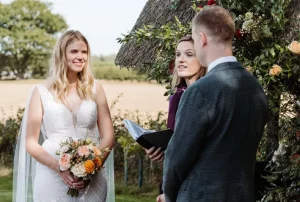ARE EMAIL WEDDING INVITATIONS TACKY?


Modernity and etiquette often clash. What we see as convenient or progressive can seem out of line or disrespectful to older generations or even some of our friends. Take wedding invitations, for example: It’s no secret that printed invitations can be stunningly gorgeous, but is it ever okay to take a shortcut and send out email invites?
Check out our expert’s take on the debate as we answer the question, “Are Email Wedding Invitations Tacky?”
Why written invitations are the gold standard
Image

First, let’s take a look at why wedding invitations are so important. When you invite people to your wedding, you’re telling them that you want them to be present at a life-changing event. That kind of message deserves some respect.
Written invitations are so much more than a piece of paper listing the venue address and the event’s date and time. From the quality of the paper to the colors you choose to little graphics and other design elements, invitations give guests a preview of your chosen theme. The right invitation sets the scene for your big day and gets everyone excited about what’s to come.
Custom invitations also pull double-duty as sentimental keepsakes. Not only are they often framed and displayed by the happy couple, but guests like the mementos too. Printing out a copy of an email invite just doesn’t have the same gravitas.
In short, your wedding invitation is like a first impression. How do you want your wedding plans to come across?
Is your wedding formal or informal?
Image

Whether or not email invitations are tacky is more of a personal opinion, but most people would readily agree that they’re definitely informal.
It’s hard to ignore the time and effort that goes into creating a great invitation, sifting through paper samples, and selecting the colors that align best with your personal aesthetic. Printed invitations are also more traditional, which seems to go hand-in-hand with formality. If you’re planning a grand affair, including a luxury venue, lots of guests, and other traditions such as a sit-down dinner and first dance, you may want the ritual of making and mailing custom invitations.
If your wedding promises to buck tradition, an e-vite may feel more on brand. A casual backyard bash with a food truck and lawn games after the “I dos” will work equally well with a woodgrain-inspired printed invite as it does with an easygoing email. Just like you wouldn’t wear a ballgown to a beach wedding or overalls to get married in a stately church, the style of your invitation should fit the style of your event.
Pssst… They’re not necessarily that convenient
Image

One of the two biggest selling points of email invites is that they save on time and money, but it turns out that might not really be the case.
There are roughly 300 billion emails sent every single day. Imagine how many of those are never opened. When your email invite fails to garner responses, you won’t know if people are being careless or if they just didn’t see it. Finalizing your guest count will require tons of follow-up calls or more emails, which hardly saves time.
Even less convenient is the fact that many of your guests may not use or like email to begin with. The chances that your Grandma Ethel is going to sign onto her Gmail account to see if she scored a seat at your ceremony is about as likely as her taking up extreme snowboarding. Sure, it could happen, but the reality is that even if you choose to send out email invitations, you’re going to need some paper invitations as well. Now you have to design two invites, coordinate two different response types, and you may even have guests who got emails ask why they weren’t “good enough” for the “real” invitation. Not a can of worms you want to open if you can help it.
Pro tip: If creating your own wedding invitations from scratch seems daunting, you may be surprised. All-in-one invitations take the guesswork out of what you should and shouldn’t include, and you’ll have templates to guide you through every step of the design process. There are even add-on services that will take care of addressing your invitations for you so you can avoid getting writer’s cramp while you should be out auditioning DJs and tasting cakes.
Now that’s convenient.
When are email invites a good idea?
Image

There are certain situations in which sending email invitations makes the most sense. If there is a very short lead time between your engagement and the wedding date, you may have no choice but to go digital. There are times, especially during a pandemic or when a couple is rushing to say their vows before one of them is deployed, that expediency is everything. There simply isn’t any way to wait for the USPS to do their job when you only have days or weeks to let people know you’re getting married.
If you’re planning a virtual wedding, email invitations can be an easy way for guests to “attend” because all they have to do is click on an embedded link — much easier than typing in a URL written on a paper invitation. This is becoming increasingly common as social distancing and plummeting venue capacities make it difficult to host larger gatherings. Some couples are choosing to have a remote ceremony and schedule a larger party once things settle down. In this case, an e-vite for the streamed ceremony and a traditional invitation for the eventual post-wedding party might be the perfect way to go.
You can still make the best of those scenarios by sending out paper wedding invitations so guests have a tangible keepsake, or you can mail out a marriage announcement introducing the newlyweds and sharing details of the big day.
Other invitation etiquette
Image

As you go about designing your wedding invitations, here are few other bits of wedding invitation etiquette to keep in mind:
- Every guest should get their own invitation unless they’re a child under the age of 18 or living with a partner or spouse that’s also invited (traditionally, one couple = one invitation unless the couple doesn’t live together)
- Invitations should be written in third person — think “Mr. James Lorry and Miss Melinda Horowitz request the honor of your presence” rather than “Jim and I would love for you to attend”
- Skip the abbreviations and spell out important information, such as dates and times
- Invitations should go out six to eight weeks before your wedding date — so as long as you have a couple months’ notice, you’re fine to go the snail mail route
- There are two things you should never put on an invitation, digital or otherwise: your registry information and the phrase “no children”
When it comes to tradition, sentimentality, etiquette, and aesthetics, it’s hard to beat a high-quality printed invitation, but that doesn’t mean they’re a requirement. At the end of the day, no one knows your preferences or your guests better than you do. Go with the option that feels right, and your decision will never be wrong.







